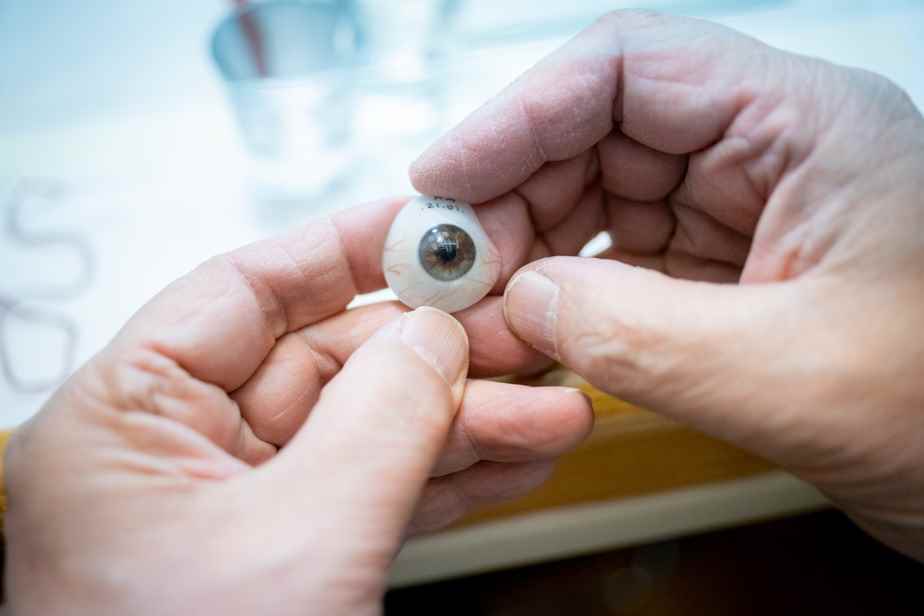Quebec has one of the least generous programs in Canada when it comes to reimbursing the purchase of an “artificial eye”. A way of doing things that harms people who need an ocular prosthesis to live a more normal life.
“We have one of the worst programs in Canada,” exclaims ocularist Jean-François Durette. For a custom-made ocular prosthesis, the Quebec government offers financial assistance of $585, once every five years. However, this amount has not been indexed for more than 30 years. It barely covers 20% of the cost of the prosthesis, which can amount to more than $2,900.
For people who have lost an eye following an illness or an accident, the prosthesis has only an aesthetic function, it does not help to regain sight. “It allows them to go unnoticed, to stop being asked questions,” says Mr. Durette. “Some people tell us that it brings them back to life,” adds ocularist Louise Boucher.
The art behind ocular prostheses
-

PHOTO DOMINICK GRAVEL, THE PRESS
Brushes and pencils are spread out on the work table. Here, at the clinic of Jean-François Durette and Louise Boucher, we don’t paint canvases, but custom-made artificial eyes.
-

PHOTO DOMINICK GRAVEL, THE PRESS
Jean-François Durette selects the iris that best matches that of his client, from a hundred color choices. “I choose the base color and then add the details,” explains Mr. Durette. Louise Boucher prefers to paint the iris directly on a black disc. “I paint in front of the client. You still have to have a certain artistic talent, ”says Mme Butcher smiling.
-

PHOTO DOMINICK GRAVEL, THE PRESS
The ocularist takes an impression of the patient’s eye socket. Then, he places the iris in a mould, which he covers with a paste of white acrylic. This piece will be baked and polished for about ten minutes.
-

PHOTO DOMINICK GRAVEL, THE PRESS
Now is the time to complete the iris. The details are traced with colored pencils and paint, while red embroidery cotton threads are used to reproduce the small veins. The eye is then coated in acrylic to seal the paint.
-

PHOTO DOMINICK GRAVEL, THE PRESS
The ocular prosthesis is now complete. The customer can keep it for about five years.
1/5
Since the 1990s, only people receiving last-resort financial assistance, such as victims of crime, social assistance recipients or people injured at work, are covered at 100%. For the rest of the low-income population, the bill is sometimes hefty. Even too salty.
There are people who have an outdated prosthesis and who cannot afford to renew it.
Jean-François Durette, ocularist
Over the years, the orbital cavity evolves and the prosthesis must be changed. “The muscles attached to the eye are no longer trained, so they can lose strength and the eye can deviate to one side or the other,” he explains.
In the last five years, 1,945 Quebecers have benefited from government assistance, according to data from the Régie de l’assurance maladie du Québec (RAMQ) obtained by The Press. The majority of them got the maximum of $585.
By comparison, British Columbia reimburses $3,000 every three years for an ocular prosthesis. Ontario reimburses 75% of the costs.
Ocularists Jean-François Durette and Louise Boucher want the RAMQ to also cover 75% of the costs. “That was it at the time, before 1991,” recalls Mr. Durette, who has been working in the field for forty years.
“It’s heartbreaking”
Last summer, Madelyne Rivest, founder of the Facebook group “Grouping of people with an ocular prosthesis of Quebec”, had to set up a crowdfunding campaign to allow an elderly lady to afford an ocular prosthesis.
This is not a unique case. Ocularists frequently encounter clients struggling to pay for their future eye. “We meet people who need a new prosthesis, but they ask us to wait because of the cost. It’s heartbreaking,” says M.me Butcher.
Madelyne Rivest regrets that some people do not have the means to buy “a look”. She knows how important it is, having had a prosthetic eye herself for two and a half years, after losing her eye to repeated retinal detachments and acute glaucoma attacks. “It allows me to work with the public and know that I won’t be stared at,” she says.
Catherine Pineau, who has been wearing an ocular prosthesis since the age of 1, also testifies to this. “I had a great adolescence, I went to university, I had a great career, I was class president, I played soccer, she says. I had a normal life, which I probably wouldn’t have had without a prosthesis. »
In Quebec, only six clinics are specialized in the manufacture of these ocular prostheses, indicates Mr. Durette. The 72-year-old plans to retire in the next few years, but succession is rare. “I don’t want everything that I’ve developed as a technique to fall through,” he says. I would like to pass it on to someone. »
